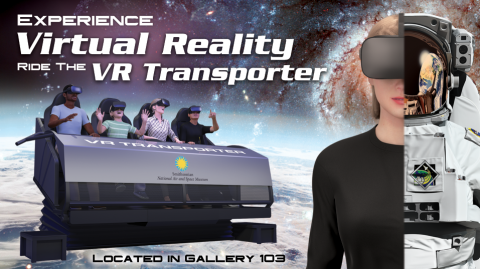New Motion-Based Virtual Reality Attraction Opens at the National Air and Space Museum
Starting April 26, visitors to the Smithsonian’s National Air and Space Museum on the National Mall can experience the thrill of leaving Earth without actually leaving the museum, thanks to an exciting new motion-based virtual reality (VR) attraction at the museum’s simulator gallery. Through an ongoing partnership between Smithsonian Enterprises and Pulseworks LLC—an Atlanta-based provider of motion-based entertainment and digital content—museum visitors can enjoy cutting-edge VR technology and gain unique perspectives on living and working in outer space.
The ticketed attraction will use an innovative new motion-based ride called the Pulseworks VR Transporter, one of the first of its kind in North America. It will feature an eye-popping, first-person adventure titled “Spacewalk: Danger in Orbit,” letting patrons assume the role of an astronaut testing a new manned-maneuvering unit as they explore the elaborate exterior of the International Space Station high above Earth.
VR is a new technology that enables people to have an immersive presence in a digital world. It uses high-tech head-mounted displays to connect users directly with content inside a three-dimensional space. Rather than simply watching a movie, users can change their perspective, explore and have their own unique experience tailored to their head movement. The VR Transporter takes VR to a new level. While VR technology mimics the immersive visuals of the real world, Pulseworks motion and effects technology reconfirms what wearers are seeing by providing input to their other senses. Dynamic motion provides important cues to the brain that they are really traveling, and stunning surround-sound audio and gripping 4-D effects heighten feelings of realism.
The VR Transporter accommodates up to four people per ride cycle. The motion platform elevates, pitches and rolls in computer-controlled increments designed to mimic the path of the would-be astronauts as they float in space on their extravehicular journey from the cargo bay of the Space Shuttle Discovery to the International Space Station.
“The VR Transporter puts guests right inside the astronaut’s helmet,” said Zarth Bertsch, director for theaters and entertainment at the Smithsonian. “Most of us can only dream about being in space, but now Smithsonian visitors can have the sensation of actually going there.”
The effect of the VR Transporter is so powerful that many guests will try to reach out and touch objects as they pass by. It is this intuitive reaction that makes the platform such an obvious tool for learning and adventure at the National Air and Space Museum, where many come to ponder dreams of flight, space and adventure.
“The VR Transporter offers a ‘wow’ moment for museum visitors unlike any other, and will allow guests to imagine themselves in almost any space or aviation scenario,” said Raj Deshpande, CEO of Pulseworks. “We are happy to offer this leading-edge technology and continue our longstanding partnership with the Smithsonian to further the educational and interactive goals of the National Air and Space Museum.”
Tickets for the VR Transporter ride may be purchased at the museum’s simulator gallery located on the first floor, adjacent to the “America by Air” exhibition. Tickets are also available at the IMAX Theater and Planetarium box offices. The National Air and Space Museum building on the National Mall is located at Sixth Street and Independence Avenue S.W. in Washington, D.C.
About Pulseworks
Pulseworks is headquartered in Atlanta where it manufactures and develops a myriad of motion simulator products and immersive content for its owned and operated attractions across North America. Founded in 1998, Pulseworks has partnered with Smithsonian Enterprises to provide motion-based simulation experiences for patrons for more than 16 years.
# # #
SI-204-2017

